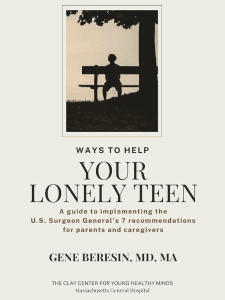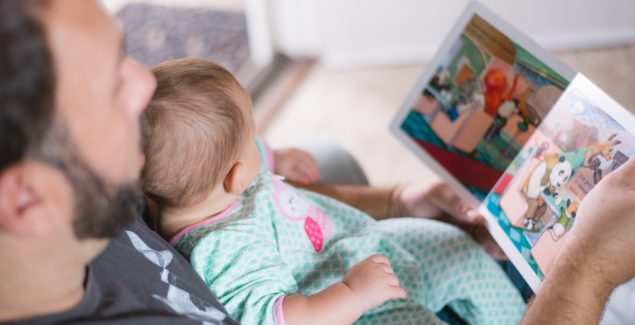9 Tips to Help Toddlers to Sleep On Their Own (and Enjoy Being Alone)

Posted in: Infants & Toddlers
Topics: Child + Adolescent Development

Order your copy of Dr. Beresin’s guide on youth loneliness.
Recently, I was teaching a seminar for child psychiatry fellows on the topic of Donald Winnicott’s Theory of Emotional Development. About a third of the group had young children.
Winnicott is less known by many parents. As a pediatrician, and later a child developmentalist, he was the first to describe some things we all appreciate:
- the role of a “transitional object” (a stuffed animal or favorite blanket – think of Linus and his blanket from the comic Peanuts);
- the notion that parents need to be “good enough,” but not “perfect” (an old misconception);
- the importance of apology and making amends after parents and children fight or do something out of line, in order to make right, absolve guilt, resolve conflict, and develop concern for others; and
- many other challenges in normal child development, including “the capacity to be alone.”
He was ahead of his time and one of the first doctors to have regular radio spots on the BBC from 1943-1965 to convey his advice to parents.
The Capacity to Be Alone
The concept of enjoying oneself when alone – the ability to relax, to reflect, to enjoy solitude and do things on our own – is not, according to Winnicott, something that just happens. It’s a skill we learn and develop through our lives. The capacity to be alone, he says, it’s one of the most important signs of emotional maturity. This includes putting oneself to sleep, and it begins in the early years of life.
When you consider that infants and toddlers are entirely dependent on parents for food, dressing, activities of daily living, and comfort, it’s no surprise that the very first time they’re really on their own is when they are put down for a nap or bedtime. And it’s natural that they may initially freak out. Separation is really scary. No one is there to hold them, rock them, snuggle them. But helping your child get to sleep on their own is not only important for you as a parent, but a critical experience for your child and their future development.
It’s not just about getting to sleep. It’s about learning to enjoy being alone and acquiring personal ways of “self-regulating” – finding unique ways of calming one’s emotions, slowing down, relaxing, and feeling safe enough to drift off to sleep.
Challenges With Toddler Sleep
In my seminar, every fellow who was a parent shared many of the common things we all experience as parents trying to get our toddlers to sleep:
- “I/My spouse can’t stand the crying! How long do we let it continue? If I hold her, then leave, the screaming starts again. It’s too painful. What do I do?”
- “I can stand the crying, but my partner can’t and that’s when we start fighting.”
- “It takes forever for her to fall asleep. How long can I deal with this and not get to other important things?”
- “He falls asleep, but then screams and won’t calm down until I bring him into our bed at night. And then it’s impossible for me to get my good night’s sleep, but at least he’s not crying.”
- Naps? Same thing: “I have to stay in the room or she won’t settle down.”
- Then many reported on THE method that’s supposed to be fool proof. But it was clear, no one method worked for everyone in the seminar.
So, what can parents do? Remember that one size does not fit all. There are a so many moving parts that can make going to sleep alone hard.
Consider your own situation:
- What inherent capabilities does your child have? For some, falling asleep is easier than others. Some of this is a biological trait the child is born with, just as some kids are picky eaters while others enjoy almost any food.
- Are there stresses at home, like a new baby, move to a new house, or fighting between parents? If these or other issues are present, falling asleep becomes harder.
- Is there something physical distressing the child – a cold, gas, asthma, or colic?
- Is the routine inconsistent? Do you rush in to hold your distressed child too soon? Does your way of doing bedtime vary a lot, so your child can’t plan on what to expect?
Second, another key concept from Winnicott: “The capacity to be alone, is the capacity to be alone when someone else is present.”
What he means is that a child’s ability to be alone depends on knowing that a loving caregiver is always present and “with them.” Once they can take that for granted, they feel less distressed, vigilant, or worried. They can relax with the underlying security that they will be taken care of.
Helping Them Feel They’re Never Really Alone
This is key to our success: We’re never really alone if we have faith that there are others in our lives who love us and will be there in times of need.
Here are some parent strategies:
- Stay with your child and gradually move away. There are many ways to do this, but the key is to be with the child, perhaps holding her, then placing her in bed and touching her, then sitting next to her, sitting further away, and so forth, so she will know you are present. Take each of these steps gradually over a period of time so the child falls asleep knowing you’re there even when you aren’t right These steps hopefully lead to your child feeling your presence even when you are out of the room – generating a sense of safety and security.
- Set up a comfortable, safe bedroom. Kids need to feel their place to sleep is conducive for calming down. Be aware of the temperature, light from windows (both for daytime naps or going to sleep after it’s dark) and use your child’s bed for sleeping – not playing – so he associates his bed as a place to rest and not get worked up.
- Find ways your child calms down. This may mean placing stuffed animals she likes in bed, or books she likes to look at, mobiles above the bed, music she loves. These all help to calm her emotions, and allow a child to settle in.
- Feed or nurse the child before bed. Many kids will fall asleep easier on a full stomach.
- Keep a regular daily routine. Eating, naps, and bedtime should be as consistent as possible, with the same structure. Example: Dinner, bath, brush teeth, stories, sleeping time.
- Talk to and play about bedtime and napping. This means playing with stuffed animals around going to sleep; reading stories about bedtime; commenting that mommy, daddy, and baby animals all go to sleep.
- Decide how much crying is OK. This is tricky as there is no fixed amount of time that is a golden standard. You and your partner (or you alone, if a single parent) need to appreciate how much crying is ok for your toddler, and also assess when it builds into such a frenzy that self-calming is impossible. But going in to hold your toddler too soon after a simple cry only reinforces the behavior that crying means mom or dad will pick me up. By the same token, determine how much can you take without your feeling so stressed and guilty that you cannot get to sleep!
- Get good activity during the day. Our toddlers need to have a good amount of exercise and fresh air to be able to get the sleep they need.
- Remember, it’s a marathon not a sprint. Learning to go to sleep is not a quick fix for most kids. Further, there may be times your child does fine but then something shifts and it feels like it’s back to square one (it really isn’t, even though it feels that way). This may be the introduction of a new sibling, stress at home such as unemployment, the move to a new home, or other changes in life.

Please take a 1-minute survey about this article.
There have been many wonderful articles and books with guidance on helping your child fall asleep on their own. Most focus on the importance of adequate sleep for optimal child physical development, as well as the valuable means for parental well-being.
But let’s not also forget the emotional value for the child. We want our kids to grow up autonomous and appreciate the capacity to be alone. Being alone is a way to relax, process our experiences, use ourselves in the most productive ways for personal productivity at work and in creative endeavors, and to simply enjoy our own solitude without any fears of missing out or a need for others to make us feel secure.
Helping our toddlers get to sleep alone is one of the first steps in their developing their lifelong capacity to be alone, while knowing the most beloved in their lives (present and passed) are with them.


 Share
Share Tweet
Tweet





